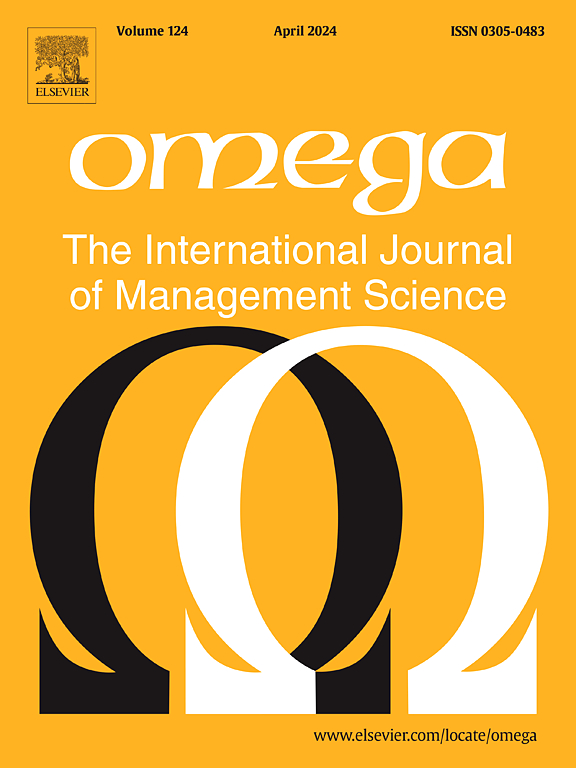稳健的性能评估与改进:打开权重空间的黑盒子
IF 7.2
2区 管理学
Q1 MANAGEMENT
Omega-international Journal of Management Science
Pub Date : 2025-08-06
DOI:10.1016/j.omega.2025.103409
引用次数: 0
摘要
数据包络分析(Data envelopment analysis, DEA)在绩效评价过程中可能会陷入极值权值。为了获得稳健的评价结果,一种可能的方法是打开权重空间的黑盒。在这种情况下,主要面临两个挑战:1)如何确保绩效评估的可重复性;2)如何找到最优的绩效改进路径。本文首先提出了一种能够对输入输出权值进行非随机采样的网格生成算法,这意味着采样结果具有可重复性。在此基础上,我们可以接近每个决策单元(DMU)的效率比分布曲线,从而更详细地了解效率评估。为了描述评价结果,我们用优势效率概率(DEP)代替效率优势的概念,并利用排名期望和排名方差分析排名区间。进一步证明了几个重要性质。此外,我们提出了一种基于效率弹性最大化原则的分步性能改进算法。最后,我们通过一个实际案例研究来说明我们的方法的可用性。主要贡献包括:1)提出了一种打开权值空间黑箱的权值采样算法,保证了评价结果的可重复性;(2)将绩效评价指标扩展到DEP、排名期望和排名方差的框架中,可以更全面、更稳健地为决策者提供评价信息;Iii)从效率弹性的新视角提出了一种性能改进算法。本文章由计算机程序翻译,如有差异,请以英文原文为准。
Robust performance evaluation and improvement: Opening the black-box of weight space
Data envelopment analysis (DEA) may fall into the extreme weights during the performance evaluation process. To obtain robust evaluation results, a possible way is opening the black-box of weight space. In this scenario, there are two main challenges: i) how to ensure the repeatability of performance evaluation, and ii) how to find the optimal performance improvement path. In this paper, we first propose a grid generation algorithm that can sample the input-output weights non-randomly, which means the sampling result can be reproducible. Based on this, we can approach the efficiency ratio distribution curve of each decision-making unit (DMU), which reveals more detailed insights into efficiency assessment. To describe the evaluation result, we replace the concept of efficiency dominance by dominance efficiency probability (DEP), and analyze the ranking interval by employing ranking expectation and ranking variance. Several important properties are further proved. Moreover, we propose a step-by-step performance improvement algorithm based on the principle of efficiency elasticity maximization. Finally, we illustrate the availability of our method by a real-world case study. The main contributions include that i) we propose a weight sampling algorithm to open the black-box of weight space, which can ensure the evaluation result is reproducible; ii) we extend the performance evaluation indicator to the framework of DEP, ranking expectation and ranking variance, which can provide evaluation information for decision makers more comprehensively and robustly; iii) we propose a performance improvement algorithm from the new perspective of efficiency elasticity.
求助全文
通过发布文献求助,成功后即可免费获取论文全文。
去求助
来源期刊

Omega-international Journal of Management Science
管理科学-运筹学与管理科学
CiteScore
13.80
自引率
11.60%
发文量
130
审稿时长
56 days
期刊介绍:
Omega reports on developments in management, including the latest research results and applications. Original contributions and review articles describe the state of the art in specific fields or functions of management, while there are shorter critical assessments of particular management techniques. Other features of the journal are the "Memoranda" section for short communications and "Feedback", a correspondence column. Omega is both stimulating reading and an important source for practising managers, specialists in management services, operational research workers and management scientists, management consultants, academics, students and research personnel throughout the world. The material published is of high quality and relevance, written in a manner which makes it accessible to all of this wide-ranging readership. Preference will be given to papers with implications to the practice of management. Submissions of purely theoretical papers are discouraged. The review of material for publication in the journal reflects this aim.
 求助内容:
求助内容: 应助结果提醒方式:
应助结果提醒方式:


